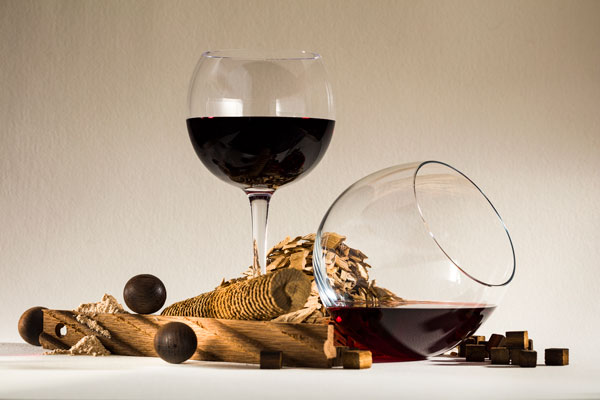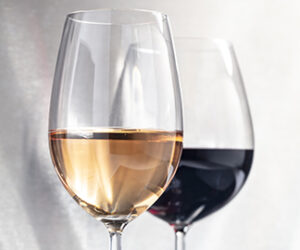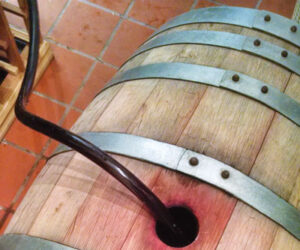Dialing it in

When you make a wine at home, you plan for a delicious beverage that you can enjoy with family and friends. Occasionally, though, a wine doesn’t turn out exactly as you wanted. Before you consider throwing it out or turning it into vinegar, give some thought to ways you might improve that wine’s flavor after fermentation. Some of the common adjustments are so deeply rooted in traditional winemaking that we just consider them part of the process and not alterations at all. Other adjustments are less common but still part of mainstream winemaking. Since we are home winemakers unrestricted by traditions or marketing concerns, we can go further afield. Starting with “conventional” adjustments and moving more off-center as we go, to follow are some suggested techniques for improving the taste of your wine after it has been fermented.
One very common way to change the flavor of wines, especially reds, is malolactic fermentation, or MLF. Inoculating the wine with liquid or freeze-dried MLF bacteria culture immediately after fermentation will lower the titratable acidity (TA), produce a mellower flavor, and possibly even add some buttery notes due to diacetyl production. In some instances, winemakers inoculate the wine while it is still undergoing primary fermentation, in which case this might not even be considered a “post-fermentation” adjustment.
Oak Treatments
Another very traditional treatment is the use of oak. When, in winemaking history, the oak barrel largely replaced clay amphorae as bulk storage containers, the results were better than expected. Not only was the barrel a stronger container that could be produced and transported in larger sizes, it also had a beneficial effect on wine quality. The oak staves were heated over an open fire of oak scraps to become flexible enough to bend. The resulting “toasting” of the natural wood sugars imparted pleasant flavors and aromas to the wine while oak tannins contributed body and structure.
Barrel aging has long been the most prestigious method of oak addition, but modern winemaking has given us many new methods. At your local home winemaking shop, you can find oak sticks, staves, and spirals to put in carboys, tanks, or neutral barrels. There are also cubes, balls, and chips of oak wood toasted to various levels for different flavors and aromas. Oak powder or liquid oak extract act on the wine very quickly to add desirable aromas and flavors. Because it acts so quickly, liquid oak extract is a good stand-in for other oak products when doing a bench trial.
If you think your wine might be improved by aromas, flavors, and tannins from oak, do a trial on samples using extract. Once you have answered the question, “is it better with oak?” you can go on to decide what oak product you want to use. As a rule of thumb, the larger the pieces of wood, the longer the contact will be for full extraction.
Tannins
Closely related to oak products are tannin addition materials. You can buy grape tannins to boost a wine that is low in natural tannins or to add body to wine made from another fruit like peaches. Tannins derived from oak come in many formulations, broadly divided into fermentation tannins, aging tannins, and finishing tannins. The latter two classes fit today’s theme of post-fermentation adjustments. There are also tannin products derived from other woods, including the South American hardwood Quebracho and even citrus wood.
If boosting the body, astringency, or bitterness of your wine seems like a good idea, you can do bench trials with tannin products just as with oak extract. Calculate a range of additions you might like or select a range of tannin products, dose wine samples, and hold in the dark overnight. Tasting the samples the next day should reveal whether you have made an improvement and, if so, which program seems most effective. When you treat your bulk wine, start by making only half the addition that results from the trial, taste after a few days, and add the other half if you have not already achieved your desired result.
Acidity
You may conclude that a finished wine would taste better with a higher or lower acid content. If you want to increase acidity, use tartaric acid. Since wine typically contains about 4 to 6 grams per liter of TA, acid additions will probably fall in the range of about 0.5 to 2 g/L. Tartaric acid dissolves readily in wine, so you can set up trials quite easily. Once again, let your acidified samples stand overnight and then taste before making the acid addition to the bulk batch. This is another case where you might want to add half the calculated amount, taste again, then make a second addition if it is still needed.
In the opposite direction, you have several choices of materials to lower the TA if the wine tastes too acidic. I usually use potassium bicarbonate for this purpose — it takes about 0.9 g/L to lower the TA by 1 g/L. It is not recommended to adjust more than 2 g/L of TA because of a risk of introducing a bitter or salty taste. Other materials that can be used for lowering TA include calcium carbonate, which requires 0.6 g/L for a 1 g/L reduction and potassium carbonate, requiring 1 g/L addition for a 1 g/L adjustment. Once again, do bench trials to be sure you are improving the wine’s flavor before you treat the bulk wine.
Blending
Some finished wines can be improved through blending, but this technique is a bit tricky for home winemakers. To balance whatever deficiency your wine exhibits, you need to have on hand (or make) a wine with a corresponding strength. For instance, if a red wine is thin and lacking in tannic structure, you will need a bold and robust tannic wine for the blend to be an improvement.
Commercially, wineries can buy bulk wines that exhibit characteristics they need for a good blend. You can do this to some extent at home by buying a few bottles of wine that may help improve your own, but this is probably only worthwhile for a small addition. To samples of the wine you wish to improve, add one or more commercial wines that you think will provide a good balance.
If the amount to add, cost, and quality of results are all favorable, go back and buy some more to improve your batch. One caution about blending two or more of your homemade wines is to make sure your overall production is improved. You don’t want to blend away an excellent wine just to raise a different mediocre wine up to “good.”
Sweetening
Most people enjoy a sweet taste. While many wine drinkers mostly drink “dry” wines, a little presence of sugar can be beneficial. We can look at the world of sparkling wines to see a range of added sweetness in almost all of them, even those labeled “brut.” The high acid of grapes picked at lower Brix, combined with the acidity of carbon dioxide bubbles, are offset nicely by a couple of grams per liter of added sugar. If you have a wine that seems sharp, sour, or bitter to the taste, do a sweetening trial.
When I make rosé wines or hard cider, I often do a sweetening trial to check for improved character. The best taste often comes in the range of 10 to 20 g/L (equivalent to 1 to 2%). Introducing sugar to your bulk batch requires some additional care to avoid unwanted refermentation. Calculate the amount of sugar needed — plain cane sugar or sucrose is fine. Boil the sugar for one minute in an equal weight of water to sanitize it. Stir into the wine, then add potassium sorbate to prevent refermentation.
Do not use sorbate when MLF bacteria may be present and do not neglect your sulfite program even with sorbate. Sorbate prevents yeast from growing but does not inhibit other spoilage organisms. If you are sweetening a méthode traditionnelle sparkling wine, the riddling step you use to remove yeast means you will not need to add sorbate. For white or rosé wine (or cider) that you will serve on draft from a chilled keg, you can also skip the sorbate as a storage temperature around 39 °F (4 °C) will inhibit yeast growth.
Do not use sorbate when MLF bacteria may be present and do not neglect your sulfite program even with sorbate.
To impart a slight impression of sweetness without introducing fermentation instability, you may want to try gum arabic. Readily available as a liquid addition product, this extract of acacia tree sap is simple and convenient to use; only small quantities are required. One caution with this material is that it should be the last thing you add before bottling. It may interfere with filtration, so if you are filtering, do that before adding gum arabic. For your bench trials, you can skip the filtration and go directly to addition and tasting.
There is another approach to adding sweetness that may also improve color and contribute fruitiness to a lackluster wine. That is to add grape concentrate. Available in cans, cartons, or bottles, this pasteurized concentrate of grape juice is shelf stable while unopened. If you open a container for bench trials, keep the remainder refrigerated in a sealed container until you make your bulk additions.
Grape concentrate is available in several different varieties and is usually packaged at about 68 °Brix. Since you will be doing bench trials anyway, you can just treat this number as being about 2⁄3 sugar by weight. That is, for every 2 grams of sugar you want to add, use 3 grams of concentrate. Calculate a sweetening trial just as described above for sugar, dose your samples, and see if you get an improvement. Just as when adding sugar, you will need to use sorbate if you sweeten with concentrate.
A related class of materials, but going a bit further outside winemaking tradition, is concentrated syrups of other fruits. If, for instance, your home-grown Cabernet Franc is lacking the raspberry character you crave (and is bitter or astringent), you can sweeten with raspberry syrup. Just like grape concentrate, you can buy these syrups packaged in quart or liter containers. If the container is labeled in Brix, you can work directly with that. If not labeled in Brix, look to the nutrition panel and calculate it yourself. For instance, one raspberry syrup that I looked up has a serving size of one ounce (to make a glass of raspberry drink) and that one ounce contains 13 grams of sugars. If we assume the ounce is by weight, or 28.3 g, then the Brix would be (13/28.3) x 100 or 46 °Brix. Do a sweetening and flavoring trial just as for grape concentrate.
For our most extreme flavor adjustment, I will pass along one that I have not tried myself. When I was a partner in a home winemaking store, we had a customer who made a red wine lacking in berry flavors that he was looking for. At that time, we sold fruit extracts in small bottles, primarily for homebrewers to use in flavoring fruit beers. Our customer tried the blackberry extract in his red wine and later told us it worked well for him. You can find fruit extract flavorings online, usually intended for use in desserts. These are generally alcohol extracts of real fruit and some are described as sugar-free. If you try one of those, it seems likely that adding some to your wine would not cause refermentation. As noted, I haven’t done this, so proceed cautiously. Who knows, you may turn a disappointing wine into something wonderful!







